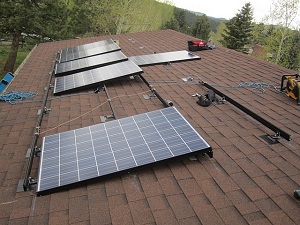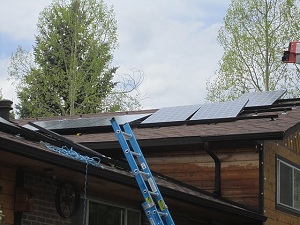A look inside a residential solar installation
Tom Gard, a retired math instructor, who taught at Evergreen High School in Evergreen, Colo., and his wife Barbara Jean are the latest in their neighborhood to get their power from the sun.
The couple is having a 6.5-kilowatt system installed on their ranch-style home. The installation is being installed by Boulder, Colorado.-based Namasté Solar. They could have chosen to buy the system outright, but instead chose to go with a solar lease through SunRun.
“I just liked everything about it. You could buy the system and install it yourself or have somebody install it,” Gard said. “But then you’re responsible for all maintenance going forward. You’d certainly have manufacture’s warrantees, but the panels, they’re warranted for 10 years. SunRun incorporates a trust account for maintenance. That, going forward, is a 20-year warranty,” Gard said.
The SunRun warranty covers the inverter, the panels, and the labor, he said.
“It’s electronic, it could break,” he said. “So I thought that was really appealing.”
Gard also chose the lease-option because SunRun monitors the array.
“They communicate with the system hourly or minute by minute. They can see what it’s generating, and they can look at the totals for the day, the week, the month, the year. They know what it’s designed to do, and you can see it on your computer. You log into the website, put in the account number and you can actually see how your performance is ranked against the expected performance. It’s almost like a stock market index. An energy index, it’s really cool. If something malfunctions, they know about it right away.”
Since the array is being installed through a solar lease with SunRun, Gard didn’t have to shell out the $25,000-$30,000 of upfront costs to go solar. In fact, when all is said and done, he’ll be paying about $78 a month for the lease for the next 20 years.
Believe it or not, this is the second time the Gards have gone solar.
In 1984 they installed a solar hot water heater on their roof.
“It did my domestic hot water and half of my space heat,” he said. “It was 27-years old, and it had a life-expectancy of 20 years. Compared to this [new system], it was pretty old technology. It worked well. It really was a lot of fun to have as much hot water as you wanted.”
The new array will be installed within two days, said Jim Bakhaus, one of the Namasté solar installers at the site.
“This particular job is going to take us a day and a half to two days,” he said. “It’ll technically be hooked up to the grid tomorrow. However, it can’t be turned on officially until the final inspection.”
The array is inspected twice, first as it’s being put up and then before the Gards are able to start net metering, Bakhaus said.
“Once it’s complete, they’ll do a final inspection to make sure all the electrical wiring is done properly and that we’ve done all the work correctly” he said. “Then they’ll release the meter. They tell Xcel it’s OK to put in the new bidirectional meter, and after that it takes about 10 business days.”
In about two weeks, the array will be feeding the home and the grid.
Gard had been thinking about going solar for a while.
“I knew about it about a year and a half ago. But I didn’t really know if I wanted to do it. The idea’s totally appealing. But I just had to see if it was right for us,” he said. “I had some friends that got interested in it, and one of them put it in a year ago, and of course there’s a lot of solar companies that manufacture panels and people that install, so I said ‘OK, I want to check on this.’ I saw Jim’s [check back for more about his array] installation and did background on Namasté and found out how much they were involved in solar installations. It’s pretty much the main thing they do.
 “Then SunRun, the company that really operates the lease and offers the lease has a very good reputation and a lot work in California and here,” Gard said. “Of course Xcel has the incentives. So it all came together. It took a while, maybe six months before I really said let’s do it.”
“Then SunRun, the company that really operates the lease and offers the lease has a very good reputation and a lot work in California and here,” Gard said. “Of course Xcel has the incentives. So it all came together. It took a while, maybe six months before I really said let’s do it.”
The family chose to go solar last fall and applied then, locking in higher incentive rates from Xcel Energy than they could get today. But knowing they had a long, five-month vacation, which included stops in Texas, California and elsewhere, they decided to wait until Spring to install the system.
“If we would have been here, we probably would have had it in already,” he said.
When making the decision to go solar, Gard drew on his past.
“I was a mathematics instructor for 34 years. So numbers are kind of fun, especially if numbers look good to you, meaning they’re saving you money, and you’re doing a good thing,” he said. “I ran a bunch of sheets on it, spreadsheets looking at my energy consumption and what I could expect this [system] to generate, and what it would cost me going forward. They have everything pretty much mapped out for you as far as payback, initial investment and they want a pretty good estimate of your energy usage.”
The system that was designed for the house will provide up to 95 percent of Gard and his wife’s electric needs, he said. It will produce more power than needed most days and feed the excess back into the grid, running their meter backwards and allowing them to essentially bank excess energy.
 “When we conserve or don’t use as much, it goes into a bank, which is kind of neat, and if you’re deficient in a month, you can draw on that bank and it balances out,” he said.
“When we conserve or don’t use as much, it goes into a bank, which is kind of neat, and if you’re deficient in a month, you can draw on that bank and it balances out,” he said.
At first, the system won’t save the Gards much money. Their electric bill, prior to the installation, was about $86 a month, he said. But he modeled a roughly 5 percent increase per year.
“So it would double in about 14 years. But that might be conservative. If it is, then I think solar gets a lot more attractive to people even without incentives,” he said. “The thing is, if you look at your payback, it’s really small until you hit year 7 or 8. Then things start to increase.”
Check back for future installments of our residential solar installation coverage, and if you have an upcoming installation on your home, please contact us.



